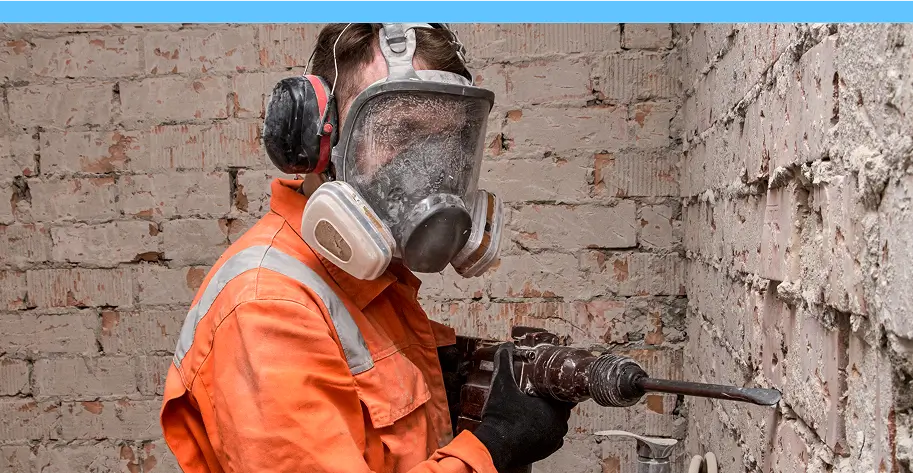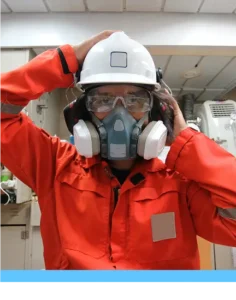
Fit testing ensures a respirator forms a secure seal to protect against hazardous airborne contaminants. This FAQ explains the difference between qualitative and quantitative fit tests (QLFT vs. QNFT), covers OSHA compliance requirements, and explores why using a professional testing provider can improve safety and efficiency.
Occupational health risks like silica, asbestos, or hazardous fumes require proper respiratory protection. A poor fit compromises even the best air-purifying respirators, so a fit test determines whether a respirator forms a proper seal on the wearer’s face.
OSHA mandates fit testing under 29 CFR 1910.134 for anyone using a tight-fitting respirator in the workplace. A specific fit factor (the measurement of how well a mask fits) must be achieved to be
considered safe.
There are two main types of fit test: qualitative fit tests (QLFT) and quantitative fit tests (QNFT).
A qualitative fit test (QLFT) is a pass/fail method that relies on the wearer’s sense of taste or smell to detect mask leakage. During the test, a harmless agent like saccharin (sweet) or Bitrex (bitter) is introduced into a hood while the wearer performs movements such as talking and bending. If the wearer can detect the agent, the mask doesn’t fit properly.
QLFT is subjective and best suited for tight-fitting respirators like N95s and half-facepiece masks. It cannot measure fit factor or detect small leaks, and is not suitable for full-face respirators.
A quantitative fit test (QNFT) is an objective method that uses specialized equipment to measure the amount of leakage between a respirator and the wearer’s face. It calculates a numerical fit factor by comparing particle concentrations inside and outside the mask, eliminating human bias.
Common QNFT methods include ambient aerosol testing and controlled negative pressure. QNFT is required for full-facepiece respirators and tight-fitting powered air-purifying respirators (PAPRs), and is ideal for high-risk environments. Per NIOSH standards, a fit factor of 100 is required for half-face and 500 for full-face respirators.
The right fit test depends on your environment, respirator type, and compliance needs. OSHA permits either method for certain respirators but requires QNFT for others based on the protection level needed. While QLFT is faster and more affordable, QNFT offers greater accuracy and objectivity.
Use a quantitative fit test (QNFT) in high-risk settings or when meeting strict safety standards, especially for full-face or powered air-purifying respirators.
A qualitative fit test (QLFT) may be acceptable for N95s or half-face masks in lower-risk environments.
While OSHA allows employers to conduct their own fit testing, safety consultants commonly suggest that organizations bring in certified safety professionals for several important reasons.
Fit testing is governed by OSHA’s Respiratory Protection Standard (29 CFR 1910.134). A professional service helps minimize legal risk and ensures that:

Quantitative fit tests in particular require expensive, highly sensitive equipment, and many companies don’t own or want to maintain this equipment. Meanwhile, safety vendors provide regularly calibrated devices and up-to-date technology to reduce the burden on internal teams and to ensure accurate results.
Employees require medical clearance for respirator use before undergoing fit testing. Professional safety companies can coordinate clearance with occupational health providers and provide necessary documentation for each employee’s record.
Using a third-party safety provider helps eliminate internal bias or shortcuts that may compromise the testing, providing greater confidence in results and documentation that stands up to audits or legal scrutiny. An outsourced testing process also adds credibility in unionized environments or regulated industries where third-party validation is preferred.
While doing the fit testing, a professional safety services provider can also analyze related equipment, such as breathing air tanks, regulators, or supplied-air systems. This integrated approach ensures the entire respiratory protection system is functional and compliant, not just the facepiece seal. It’s always beneficial to get additional insights and assessments of your industrial hygiene.
A respirator fit test applies to the complete device, including filters and head straps. A facepiece fit test typically refers only to the portion that seals against the face. However, it’s worth noting that OSHA sometimes uses the terms interchangeably.
OSHA mandates that:
“It’s also critical to understand that the employee must be fit tested on the exact make, model, style, and size of respirator they’ll be using,” says Jeremy Warren, Operations Manager at SITEX. “In some instances I’ve encountered employees who assume one successful fit test covers every respirator which is not the case.”
To ensure a proper respirator fit, start by performing a user seal check every time the mask is worn to confirm an airtight seal. Provide employee training on respiratory protection, and regularly inspect and replace facepieces that show signs of wear or damage. A proper fit also depends on several key factors:
Without appropriate fit testing, you and/or your employees may be subject to:
According to OSHA, respiratory hazards contribute to thousands of illnesses annually and proper respirator fit testing is the first line of defense.
SITEX has expertise in qualitative and quantitative fit testing for all types of industries. Whether you’re seeking to meet OSHA requirements, improve employee safety, increase process efficiency, or simply need guidance choosing the right respirator, our certified experts are here to help.
Use the form to contact us about scheduling on-site fit testing services.
Sources:




